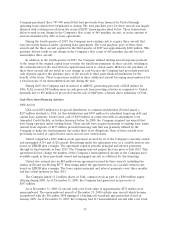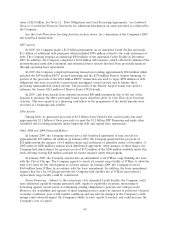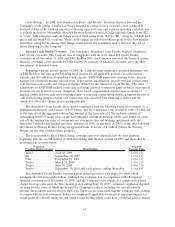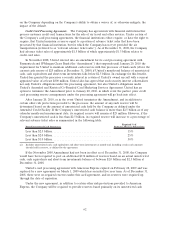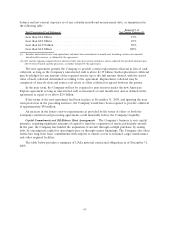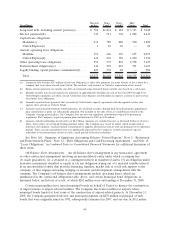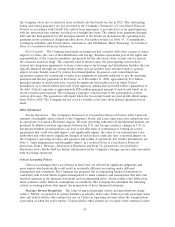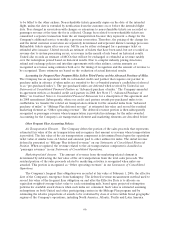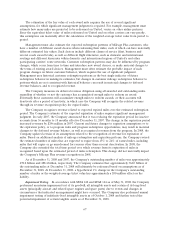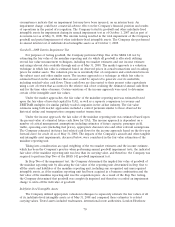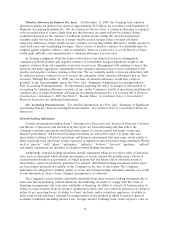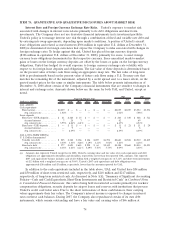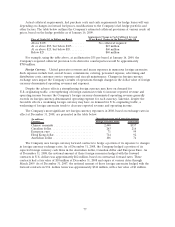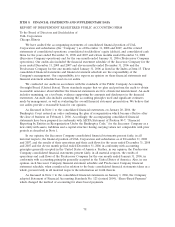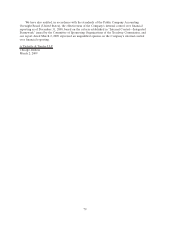United Airlines 2008 Annual Report Download - page 69
Download and view the complete annual report
Please find page 69 of the 2008 United Airlines annual report below. You can navigate through the pages in the report by either clicking on the pages listed below, or by using the keyword search tool below to find specific information within the annual report.indicated a potential impairment of value. This impairment analysis resulted in an additional fourth
quarter impairment charge of $107 million related to the Company’s B737 fleet. This additional
impairment charge was due to changes in market conditions and other conditions, including but not
limited to the cancellation of multiple letters of intent that the Company had to sell B737 aircraft, that
occurred since the impairment testing performed in the second quarter of 2008.
Due to the unfavorable economic and industry factors described above, the Company also
determined in the second quarter of 2008 that it was required to test its $91 million of pre-delivery
aircraft deposits for impairment. The Company determined that these aircraft deposits were completely
impaired and recorded an impairment charge to write-off their full carrying value and $14 million of
related capitalized interest. The Company believes that it is highly unlikely that it will take these future
aircraft deliveries and will therefore be required to forfeit the $91 million of deposits, which are not
transferable.
As a result of the impairment testing described above, the Company’s goodwill and certain of its
indefinite-lived intangible assets and tangible assets were recorded at fair value. In accordance with
FASB Staff Position No. 157-2, Effective Date of FASB Statement No. 157, the Company has not applied
Statement of Financial Accounting Standards No. 157, Fair Value Measurements (“SFAS 157”) to the
determination of the fair value of these assets. However, the provisions of SFAS 157 were applied to the
determination of the fair value of financial assets and financial liabilities that were part of the SFAS 142
Step Two goodwill fair value determination.
Due to extreme fuel price volatility, tight credit markets, uncertain economic environment, as well
as other factors and uncertainties, the Company can provide no assurance that a material impairment
charge of aircraft or indefinite-lived intangible assets will not occur in a future period. The value of our
aircraft could be impacted in future periods by changes in the market for these aircraft. Such changes
could result in a greater supply and lower demand for certain aircraft types as other carriers announce
plans to retire similar aircraft. The Company will continue to monitor circumstances and events in future
periods to determine whether additional interim asset impairment testing is warranted.
Except for the adoption of fresh-start reporting at February 1, 2006, whereby the Company
remeasured long-lived assets at fair value, it is the Company’s policy to record assets acquired, including
aircraft, at acquisition cost. Depreciable life is determined through economic analysis, such as reviewing
existing fleet plans, obtaining appraisals and comparing estimated lives to other airlines that operate
similar fleets. Older generation aircraft are assigned lives that are generally consistent with the
experience of United and the practice of other airlines. As aircraft technology has improved, useful life
has increased and the Company has generally estimated the lives of those aircraft to be 30 years.
Residual values are estimated based on historical experience with regard to the sale of both aircraft and
spare parts and are established in conjunction with the estimated useful lives of the related fleets.
Residual values are based on current dollars when the aircraft are acquired and typically reflect asset
values that have not reached the end of their physical life. Both depreciable lives and residual values are
revised periodically to recognize changes in the Company’s fleet plan and other relevant information. A
one year increase in the average depreciable life of our flight equipment would reduce annual
depreciation expense on flight equipment by approximately $18 million.
Accounting for Goodwill and Intangible Assets. Upon the implementation of fresh-start reporting
(see Note 4, “Voluntary Reorganization Under Chapter 11—Fresh-Start Reporting,” in Combined Notes
to Consolidated Financial Statements) the Company’s assets, liabilities and equity were generally valued
at their respective fair values. The excess of reorganization value over the fair value of net tangible and
identifiable intangible assets and liabilities was recorded as goodwill in the accompanying Statements of
Consolidated Financial Position on the Effective Date. The entire goodwill amount of $2.3 billion at
December 31, 2007 was allocated to the mainline reporting segment. In addition, the adoption of
fresh-start reporting resulted in the recognition of $2.2 billion of indefinite-lived intangible assets.
In accordance with SFAS 142, the Company applies a fair value-based impairment test to the book
value of goodwill and indefinite-lived intangible assets on an annual basis and, if certain events or
69


